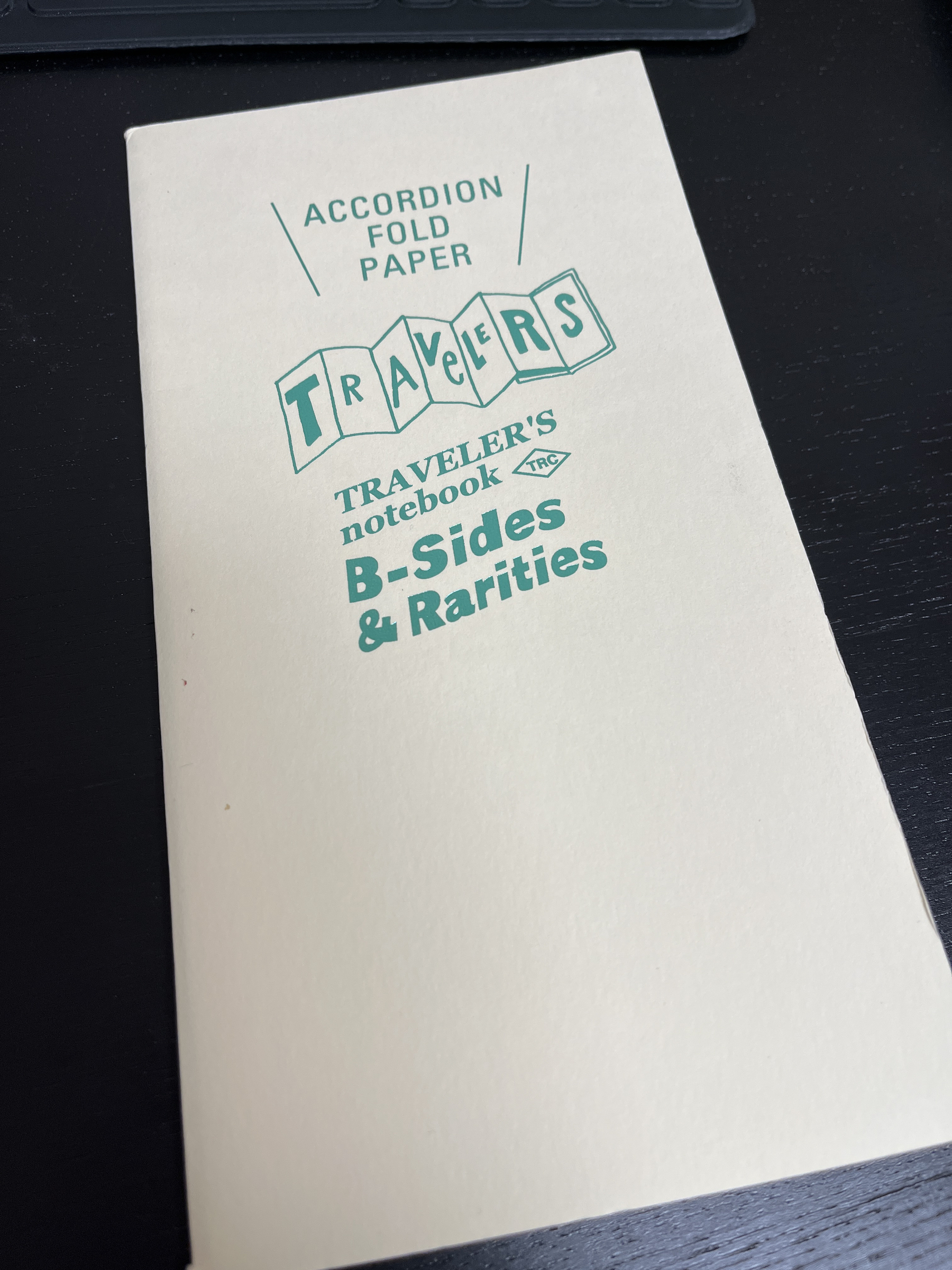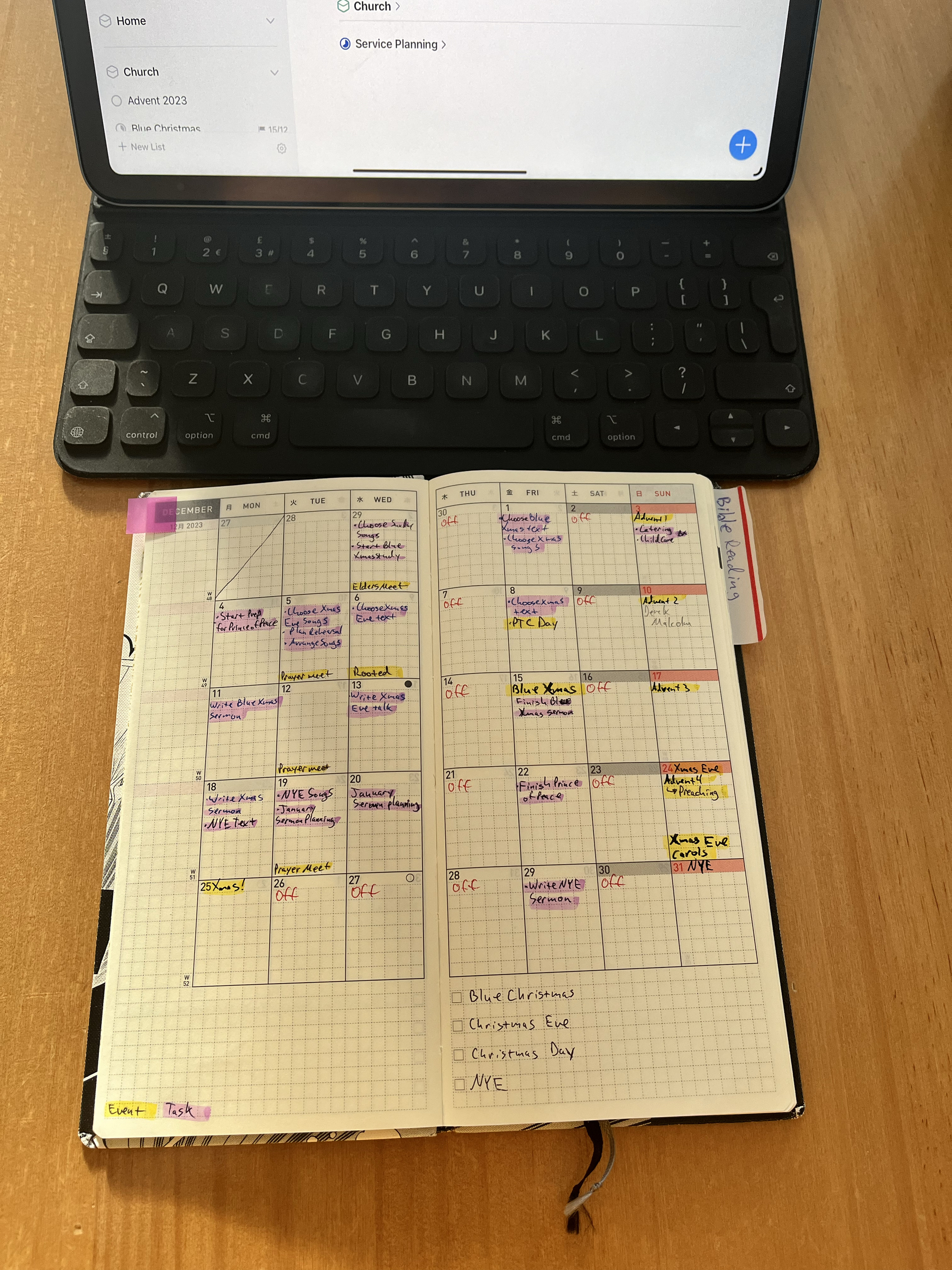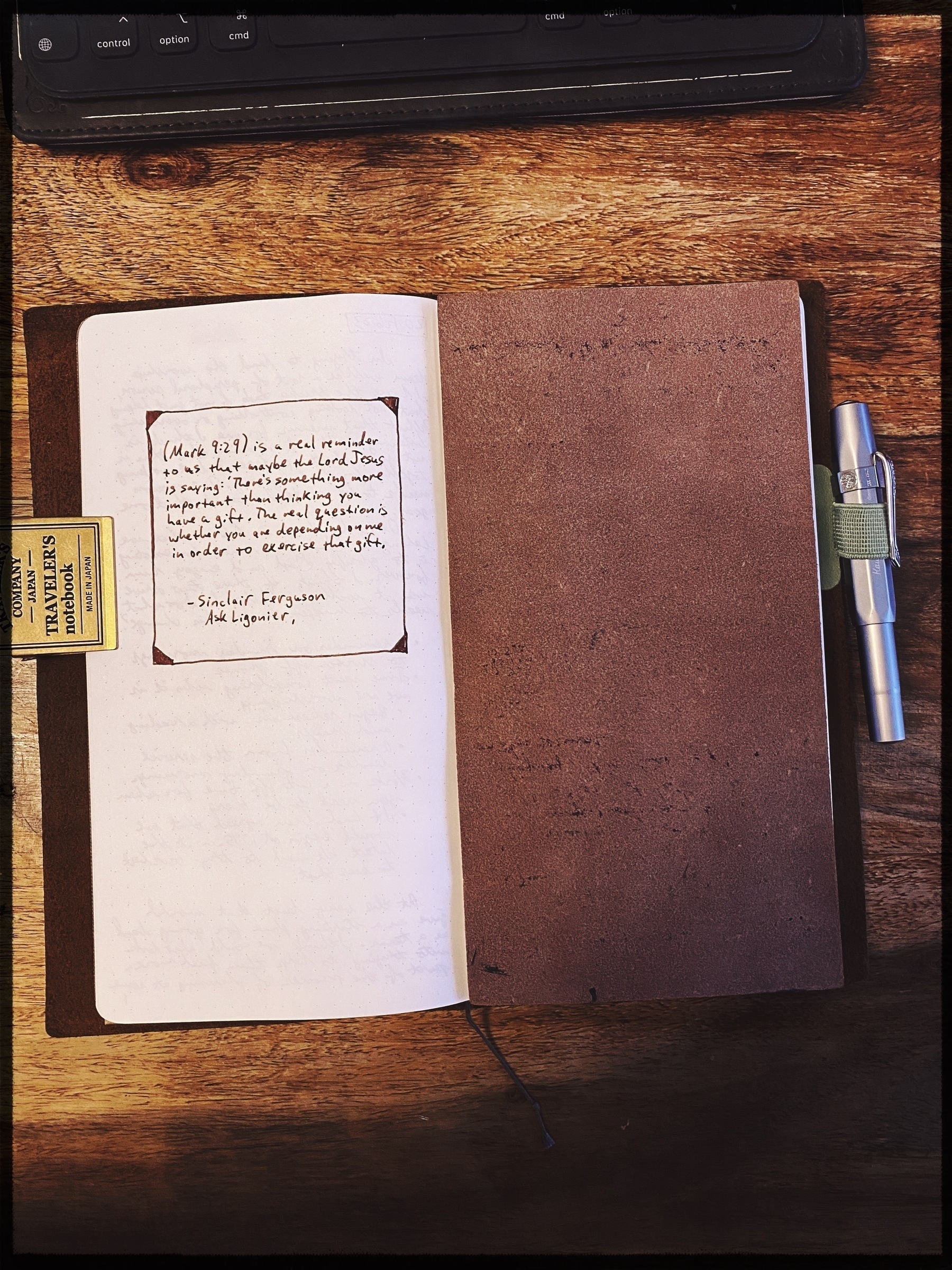Stationery
- Traveler’s Notebook (regular on camel)
- Light refill (it gives me 128 pages instead of 64, and I’m almost positive the paper in the light refills is Tomoe River)
- Lamy Safari in Fine or Extra Fine
-
I should write about this at some point. In brief, the what is the main message of the passage while the why is the application or implication for us today. ↩︎
Preaching on the Christian life and mental health this coming Lord’s Day. While these sermons have been topical/doctrinal, I’ve continued to use an anchor text and this week’s is Psalms 42-43.

📓New additions to the analogue system
I wrote recently about how I had finally figured out a sort of default setting for my analogue system. Today, a couple of things arrived in the post to help make that system even better.
Traveler’s Company archive binder
I’ve been using a Traveler’s Notebook of some sort since they were still under the Midori brand. It’s safe to say that I’ve got quite a few used refills knocking about in various places. Now, I’ve finally bitten the bullet and ordered myself some of the archive binders. They’re purpose-built, they look nice together on a shelf, and they help keep all my refills together in a way that lets me flip through them for reference.



Now I just need to make the shelf-space for them!
Field Notes Front Page
I’ve been using a pocket notebook quite a bit lately and wondered if I would benefit from switching to a reporter-style one. Something that can sit next to my iPad or whatever book I might be reading at the time.

Because I can never just use whatever notebooks are available, I decided to give Field Notes’ Front Page a go. Will have to report back on this one but it feels great in the hand and is the same height as my Traveler’s Notebook.
A stationery foundation ✒️📓
One of the things I’ve been able to figure out with stationery is that my main setup consists of:
There are occasional explorations elsewhere but that is what I always come back to.
my sermon notebook

For the last three weeks now, I have been preaching from a handwritten manuscript. After trying to work from a detailed outline instead, it is good to be back to writing out everything I intend to say. I am able to think more clearly on paper and I am also able to say things more clearly when I’ve written them out.
This has helped to bring down my sermon length but also to help me stick to the what & why1 of my sermon. I have also found Sunday mornings less stressful as I am able to read through my script focusing on how I will say the things that I have written rather than also trying to figure out the words that I will use.
But as a stationery geek, my favourite thing about doing this (and the reason why I hope to keep it going) is that I now have a notebook that is filling up with sermons. I love notebooks as objects and this one feels special now as well. I’m able to use the index in a way that will actually help me in the future and I am less relient on technology in the pulpit.

So that I’m not constantly turning pages while preaching, I opted for the larger B5-sized Leuchtturm1917 with a dot-grid.
The title and headings are written big in blue. I denote subheadings with a box around it, and the main body of my sermon is written used a green-black ink (Noodlers Zhivago). Scripture references that I intend to read out are noted in either an orange/brown (Diamine Ancient Copper) or a classic blue (Diamine Kensington Blue, one of the most well-behaved inks I have ever used).
On Sunday mornings when I look over my notes, I mark up my script with a red Uni-ball One 0.38 gel pen. I then write down the passage and title in the index and I’m good to go.
The script itself has averaged about 7-8 pages and that takes me around 35 minutes to get through. I stick fairly close to it but not as much as before I worked with an outline.
Bank Holiday so bit of a later, more relaxed start to looking at the passage I’ll be preaching in Sunday. Genesis 17 is a big chapter and it’s going to make for another interesting kids talk the following week…

One of the ways that I force myself to slowdown while studying a passage to preach is I write out the whole thing longhand. It’s an excuse to use nice stationery and to keep my handwriting in check. This week’s passage is Genesis 11:10-32.
A while back, I bought a couple of these accordion fold refills for my Traveler’s Notebook. I wasn’t sure what to do with them, thinking maybe I would make a big piece of artwork in them, but never did. Instead, I’m using one as a sort of commonplace book.


There is nothing better than paper for trying to get a sense of the big picture. Unfortunately, this paper isn’t big enough to also include figuring out when I will study for my training course.

analogue system update
It’s the middle of February, so I’m a bit late to the whole techo kaigi scene. However, I’ve recently finished a notebook so it seemed like a good time to share what I’m using for my work.
Some pastors like to craft complex and powerful Notion templates. Things which will track all of their church members, keep meeting notes and events running, and all other manner of thing. I’ve explored the dashboard and if you’re the kind of person who likes to have everything set up like that, it’s a really good option.
For me, however, I just prefer working on paper. Not because it forces me to slow down but because writing with a pen is how most of my thinking happens. It engages my brain in a way that other methods don’t. Stationery is also fun.

The Tools
My system is centred around a Traveler’s Notebook. I’m still using the camel-coloured one that I bought toward the end of our time in Poland. It’s got some scratches but is mostly starting to get a shine from being handled. Thanks to lockdowns, it’s spent most of its life sitting at a desk but it is starting to pick up more marks of being used.
I just finished up using a Galen Leather Everyday Book which used the lighter-weight 52gsm Tomoe River paper. Loved using it and seeing the paper get a little bit crinkly over time. That refill contains my first six months in my role as the pastor at our church. It’s a really nice token to have and I’m sure it will be nice to look back on in a few years’ time.
For my new refill, I’m using an A5-slim notebook by Taroko. I had some Christmas money so I used it to order a couple of these. When it arrived, I couldn’t believe that it was handmade. Everything is so neatly lined-up and square that I swore it had to be made in a factory. This notebook still uses Tomoe River paper but it’s the heavier 68gsm stock in dot-grid. I have to say that I much prefer the heavier paper. It doesn’t feel so fragile and so it seems like it will hold up better.

I’ve finally entered the world of Hobonichi planners this year, as well. I had tried a daily planner last year and found that I couldn’t get a big enough view of what was going on. So I’ve gone with a Hobonichi Weeks. I was able to order the One Piece edition from The Journal Shop and I’m really enjoying it. What I’ve found most useful is the big chunk of gridded pages at the end of the book to use for notes. It’s meant I don’t need to carry around another notebook while I’m out.
The biggest advantage to using a paper diary is that I’m able to reference it while I’m trying to keep my phone turned off. This usually happens on Mondays when I do the bulk of my sermon prep.
The Knowledge
It’s been very tempting to fall down the PKM rabbit hole. I tried using Obsidian for a while and I like the idea of this organic mass of notes growing and then finding connections between things. However…
What I’ve found in practice for myself is that I just try to save too much. My current system consists of the notebook that I’m working in (which functions as both a journal and where I do my sermon thinking). This means it’s up to my brain to make the connections to things that I remember from earlier. I’ve found this to be much better for how my brain works as I’m able to make connections between bits of information intuitively.
And whenever I am trying to remember a source for something, it’s typically in the Bible and the ESV.org search function has proven to be quick and easy.
So all I am doing to try and keep track of study notes from my sermon prep at the moment is having an index at the start of my notebook and then numbered pages. Between this and using dates on all my entries(a la Anna Havron), I don’t really see the need for back links or maps of content.